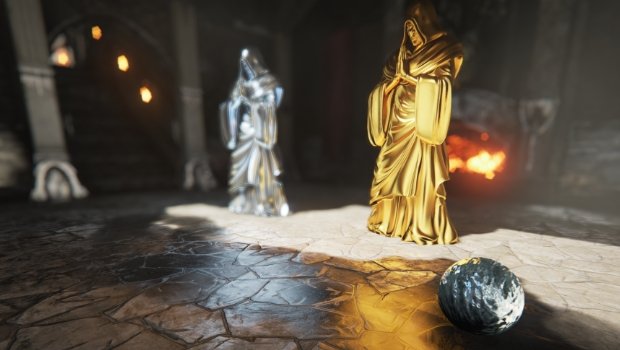Unreal Engine 4 preview Epic Games sheds light on the future of graphics
Sometimes, it’s the little things
Ever since Epic Games first teased the Unreal Engine 4’s capabilities with a handful of screens, we’ve been aching to see this graphics engine in motion. Could it really be that much more powerful? Would it be a standard-shattering leap forward for videogame visuals, or a minor upgrade to the existing tech? We decided to let the E3 2012 demo of the engine speak for itself – having seen what UE4 is capable of, we think it’ll have a colossal impact on consumers and developers alike.
Guided by Alan Willard, Epic’s senior technical artist, the demo started with a viewing of the “Elemental” concept trailer in its entirety. The intimidating, armor-clad warrior was no doubt impressive looking, though we found ourselves most transfixed by the way the engine simulating molten magma flowing down the side of the volcano-castle hybrid. It seemed our imaginations had done a fairly good job of filling in the gaps between the previously-available screens, so we were anxious to get to the new stuff.
With that, Willard ventured into the in-engine portion of the demo, plopping himself into the same throne room from the Elemental cinematic – only this version was filled with props that would demonstrate UE4’s new features. Light, and the effects that come with it, were central to this Unreal Engine’s capabilities; Willard stressed that all the light in the room was casting reflections that were rendered in real time. Each surface, as in real life, has a degree of reflectivity to it – and unlike previous graphics engines, UE4 is able to render that reflected light on the fly.
It doesn’t sound like that big of a deal – until you see what the graphics look like with the lighting effects turned off. Without the real-time reflections, the surroundings looked flat and artificial; with them, the room seemed to glow with a palpable authenticity. Metal statues shined light in every direction (with silver bouncing more radiance than copper), and Willard amplified the effect by rolling around a “ball” of water that coated the ground in an extra-reflective dampness. Even the most minute graphical details, like dust particles, caught sunlight as it beamed through the roof.
Willard continued through a series of rooms, each demonstrating the power of these light-rendering capabilities. Objects emit light due to heat; a hammer (the same one wielding by the Elemental knight) that had been heating in a hearth cast a warm orange glow across the ground – not because it had a light source within the object, but because the hot metal logically gave off its own light. Other vistas demonstrated the way sunlight refracts through billowing smoke, per-pixel lens flares shine off of bright objects, and jade statues had a lifelike luminosity to their texture.

The hype about particle effects in UE4 is no joke, either – when the screen bloomed with over a million particles red sparks of light (with nary a lag spike), we were astonished by how plainly pretty the sight was. On the opposite end of the light spectrum, plunging into darkness also has a convincing authenticity to it: UE4 also simulates eye adaptation, so your vision will slowly but surely adjust to pitch-black darkness after prolonged exposure to sunlight.
To the amazement of the group, Willard revealed that everything had been running in the engine’s development kit the entire time; this was no pre-rendered video, but actual striking visuals being rendered in the blink of an eye. Willard also used this opportunity to show off the new-and-improved Unreal Kismet, the gameplay scripting tool seen in previous Unreal Engine releases. The overhauled Kismet looks to be a bonafide boon to developers: you can “translate” what’s happening in the engine to an easy-to-read blueprint of all the scripts that are going on at any given time.
Weekly digests, tales from the communities you love, and more
By observing the engine rendering each individual piece of your program, you can literally watch code as its “happening” in real time. It’s as if a director could simultaneously view each line of script and stage direction while the actors perform their roles. If anything’s going wrong with the coding of a dev’s game, the blueprint should do wonders for axing the bug faster and more efficiently. As if that weren’t enough to help devs, you can see the source code within the engine at any time.

Unreal Engine 4 is a standalone product; Willard made it clear that one couldn’t simply “port over” existing UE3 code and expect it to look better (let alone function). Though it shares the same sleek visual style as the most advanced UE3 games, UE4’s lighting effects are no doubt awe-inspiring. It’s a kind of awe that creeps up on you; from what we saw, there’s no one effect that will stun your sense of sight on the spot.
It’s only when you stand back and look at the bigger picture and potential possibilities do you realize how huge UE4 will be for next-gen gaming, by making each and every environment feel utterly real and believable. We’re eager to see how the engine handles character models; until then, all we can do is wait with giddy anticipation for how goddang good games will look in the coming years.
Lucas Sullivan is the former US Managing Editor of GamesRadar+. Lucas spent seven years working for GR, starting as an Associate Editor in 2012 before climbing the ranks. He left us in 2019 to pursue a career path on the other side of the fence, joining 2K Games as a Global Content Manager. Lucas doesn't get to write about games like Borderlands and Mafia anymore, but he does get to help make and market them.



